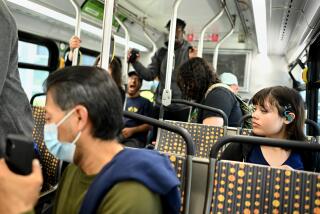Suburb-to-Suburb Commuting Now National Pattern
- Share via
WASHINGTON — Twice as many Americans now commute from suburban homes to suburban jobs as those who commute from the suburbs to the central city, a report released Thursday shows.
Moreover, this trend is likely to continue, said backers of the nationwide study, who urge transportation officials to focus on suburban growth and develop ways to improve roads there.
Suburb-to-suburb commuting has become “the predominant national commuting pattern,” said the report, which was compiled by a group of transportation-related organizations.
“The tremendous growth in suburban commuting has occurred in areas ill-prepared in terms of public facilities, roads and transit, to meet the challenge,” it said.
Census Data Studied
The two-year study, “Commuting in America,” was based on a comparison of 1960 and 1980 census data. It was sponsored by organizations including the American Assn. of State Highway and Transportation Officials, the Highway Users Federation for Safety and Mobility, the National Governors’ Assn., the U.S. Conference of Mayors and the National League of Cities.
The study found a dramatic increase in the number of jobs available in suburban areas, created by employers fleeing the congestion and high real estate costs of central cities.
Between 1960 and 1980, suburb-to-suburb commuting accounted for 58% of the increase in home-to-work trips in the nation, the report said. Commuting from the suburbs to central cities grew only 25%. Smaller fractions commuted inside central cities or from cities to the suburbs.
Suburbanites who work in central cities numbered 12.7 million in 1980, contrasted with 25.3 million who also work in the suburbs.
‘Nation in Gridlock’
Francis B. Francois, executive director of the American Assn. of State Highway and Transportation Officials, told a news conference that unless transportation planners adjust to the trend, the United States will become “a nation in gridlock.”
Mass transit options are far from adequate in suburban areas, the report said, noting that “the suburb-to-suburb market will represent . . . a very expensive-to-serve market for traditional forms of transit.”
Already, the commuter boom has increased the stress on the nation’s interstate system as local commuters and long-distance traffic often compete for the same limited road space.
The study noted that suburb-to-suburb commuting trips are 50% shorter than those for people who commute from the suburbs to center city for work. According to the study, the average commuter travels about 10 miles at an average speed of 29 m.p.h.
85% Use Private Cars
The shift to the suburbs has been accompanied by a dramatic increase in vehicle ownership. A majority of U.S. households have two or more vehicles, the report said, adding that 85% of the more than 110 million American workers now use private vehicles to commute to work.
On another point, the report said it found little evidence to support the perception that more people are working at home.
“Popular expectations of the potential for working at home and alternative travel modes to appreciably reduce commuting by private vehicle have not been realized,” the report said. As a result, “highway demand has increased even beyond the high growth expected from the job boom.”
More to Read
Sign up for Essential California
The most important California stories and recommendations in your inbox every morning.
You may occasionally receive promotional content from the Los Angeles Times.










